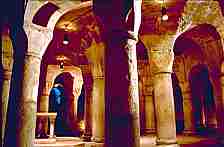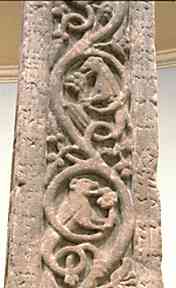





If you are looking at this page without frames, there is more information about medieval writing to be found by going to the home page (framed) or the site map (no frames).
| Literacy and the Church | |||||
| After the fall of the Roman Empire certain regions, namely Italy itself, southern France and Spain, retained a tradition of literacy in government, commerce, law and religion. Further north across Germany and France to England the mobile barbarian peoples who gained supremacy were both pagan and illiterate. Those two words can have a negative connotation, but in an absence of emotive association they simply mean they were not Christian and they had other ways of conducting their affairs or entertaining themselves than through the written word. |  |
||||
| The Roman temple at Nimes, in southern France, survived along with many other Roman physical remains and aspects of Roman culture. | |||||
 |
Literate culture was reintroduced along with the Christian religion through the establishment of monastic missions across northwestern Europe. These efforts came from different directions, which affected the nature of literate culture and writing. Efforts from Rome itself had resulted in the baptism of the Merovingian king Clovis, a symbolically significant event in the triumph of religious orthodoxy in the face of competition from the Arian heresy, and the establishment of bishoprics across France and into Kent. | ||||
| This ancient crypt beneath the former Benedictine abbey church at Dijon dates from Merovingian times. | |||||
| In the 7th and 8th centuries a missionising push came from the other direction. The survival of Romano-British Christianity is a bit obscure, but the early development of a centre of missionising Christianity in Ireland, spreading across to northern England, resulted in the establishment of monasteries of Irish and Anglo-Saxon foundation across France and Germany to Italy and Switzerland. You can believe that this was due to the efforts of inspired individuals called Patrick, Columba, Willibrord, Boniface and the others if you wish. Barbarian culture valued feats of heroic individualism and the church was very adaptable. The monasteries founded in these efforts became centres of book production and literate culture. | |||||
| This map shows the routes of missions of the 7th and 8th centuries, while this map shows the major book production centres of the 8th to 10th centuries. | |||||
| The evidence for survival of literate culture from Roman times is slight and enigmatic. Germanic cultures, including those of Scandinavia which were never under Roman rule, had the system of writing called runes. Despite all the New Age spiritualism associated with them these days, they were a form of the Roman alphabet, with different letter forms. Runic writing is mainly known from inscriptions on stone and does not appear to represent literate workings of culture in a broader sense. | |||||
 |
One of the famous runestones in the churchyard at Jelling in Denmark. (Photograph by Kaj Rasmussen) | ||||
| Just to show that nothing is simple Det Arnamagnæanske Institut illustrates the Codex Runicus (AM 28 8vo), a Danish law text of c.1300 written entirely in runes. By this date, of course, culture may be being reinvented. | |||||
 |
Runes were themselves brought into the service of the new Christian culture. Their use on monuments such as the large crosses which triumphantly proclaimed the conversion to Christianity in the north of England brought them into the domain of the new literate dispensation. | ||||
| A very worn Runic inscription can be partially made out along the edges of the vine scroll on the Ruthwell Cross in southern Scotland. The words derive from an Anglo-Saxon religious poem. | |||||
 |
The Celtic peoples also had a special script used only for inscriptions on stone, called ogham. It looks nothing like the Roman alphabet, being composed of a series of long and short strokes which were carved along the edges of monumental stones; a sort of Morse code of the Roman alphabet. The inscriptions are read around the inscribed edge. |  |
|||
| See Sharkey 1975 for a quick grab at it, and peruse the Thesaurus Indogermanischer Text und Sprachmaterialen Ogam-Inschriften website if you want to really get into it. | |||||
| It is very easy and trite to say that the church brought a whole concept of literate culture back to the barbarian regions of Europe, but can we understand just what the term literacy meant to these early churchmen and how it may have changed over the course of the middle ages? | |||||
|
|
|||||
|
If you are looking at this page without frames, there is more information about medieval writing to be found by going to the home page (framed) or the site map (no frames). |
|||||